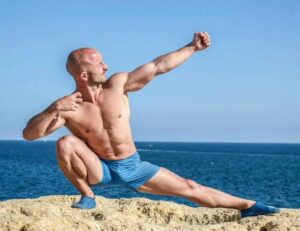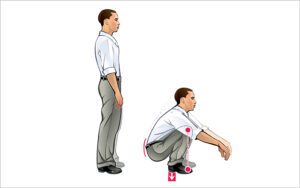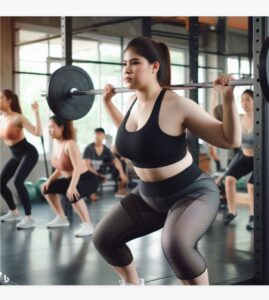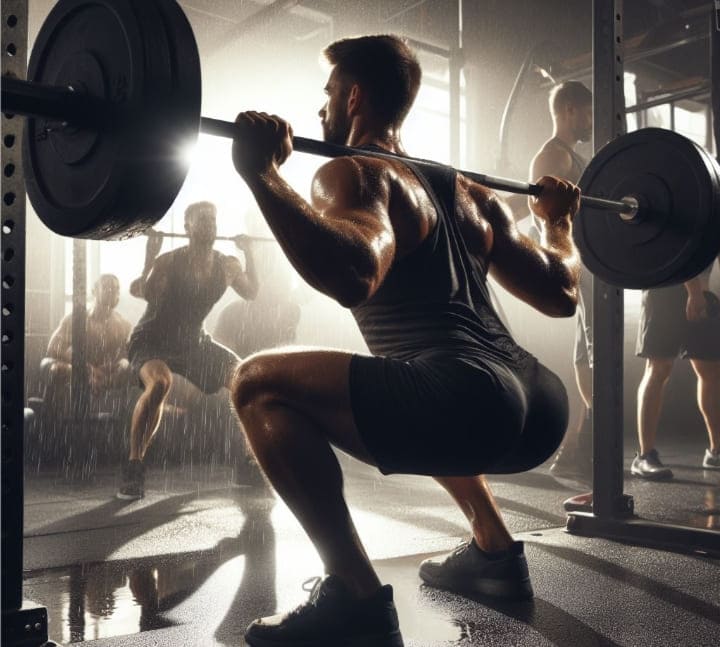
Squats are a fundamental exercise that targets multiple muscle groups in the lower body, making them one of the most effective and efficient exercises you can incorporate into your fitness routine.
Not only do squats help build strength and muscle mass, but they also offer a wide range of other benefits that can positively impact your overall health and well-being.
In this comprehensive guide, we will explore the various benefits of squats, explain how they provide each benefit, and highlight the importance of incorporating squats into your fitness regimen.
But before we dive into all the incredible squat benefits, we need to talk about squats first and make sure you have a basic understanding of this beneficial exercise
Understanding Squats
A squat is a strength exercise in which the trainee lowers their hips from a standing position and then stands back up.
Squats can be done with or without weight. When done with weight, squats are one of the most effective exercises for building muscle and strength in the lower body.
Squats can also be done as a bodyweight exercise, which is a good option for beginners or people who are unable to lift weights.
How to do Squats With Proper Form?
To do squats with proper form, follow these steps:
- Stand with your feet shoulder-width apart and your toes pointing slightly outward.
- Place a barbell across your upper back, just below your traps. Your grip should be slightly wider than shoulder-width apart.
- Take a deep breath and brace your core.
- Bend your knees and lower your hips down and back, as if you were sitting in a chair. Keep your back straight and your core engaged throughout the movement.
- Squat down until your thighs are parallel to the ground or lower.
- Drive through your heels to stand back up.
- Exhale as you stand back up.
Here are some tips for maintaining proper form during squats:
- Keep your back straight and your core engaged throughout the movement.
- Don’t let your knees go past your toes.
- Squat down until your thighs are parallel to the ground or lower.
- Drive through your heels to stand back up.
- Inhale while lowering into the squat and exhale while rising back up.
Here are some common mistakes to avoid when doing squats:
- Rounding your back.
- Letting your knees go past your toes.
- Not squatting down far enough.
- Using too much weight.
Muscles Worked by Squats
Squats targets muscle groups like quadriceps, hamstrings, glutes, and lower back. While those are the primary muscles targeted during squats, this exercise also activates a range of other muscles like both adductors, calf muscles, core muscles (such as the rectus abdominis and obliques), and even upper body muscles to some extent for stabilization.
Variations of Squats
Here are some variations of squats that you can try:
- Bodyweight squats: These squats are done without any weight. They are a good option for beginners or people who are unable to lift weights.
- Barbell squats: These squats are done with a barbell on your upper back. They are the most common type of squat and are a great way to build muscle and strength in the lower body.
- Front squats: These squats are done with a barbell held in front of your shoulders. They are a good variation for people who have shoulder pain.
- Goblet squats: These squats are done with a weight held in front of your chest. They are a good option for beginners or people who have lower back pain.
Squats are a great exercise for people of all fitness levels. They are a safe and effective way to improve overall health and fitness. Lets talk about the wonderful benefits of squat exercise.
10 Benefits of Squats
If you are wondering “what are the benefits of squats”, here are 10 incredible benefits of doing squats:
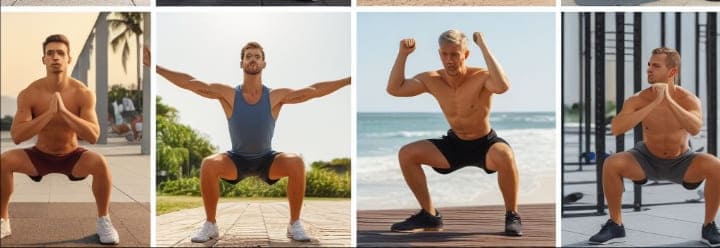
1. Strengthens Lower Body Muscles:
Squats are a powerhouse for lower body muscle development. By targeting key muscle groups such as the quadriceps, hamstrings, and glutes, squats enhance strength and endurance in these areas.
The quadriceps, situated at the front of the thighs, are primarily engaged during the upward phase of the squat. Simultaneously, the hamstrings, located at the back of the thighs, work to stabilize and control the descent.
The glutes, often referred to as the body’s powerhouse, play a pivotal role throughout the movement, facilitating hip extension and promoting stability.
Strengthening these muscle groups is critical for everyday movements like walking, running, and maintaining balance, underscoring the paramount importance of squats in a well-rounded fitness regimen.
2. Boosts Core Strength and Stability:
While squats are renowned for their effects on lower body strength, they also significantly impact core muscles. Engaging core muscles, including the rectus abdominis and obliques, during squats is essential for maintaining stability and proper form.
The core serves as the body’s foundation and plays a crucial role in balance and posture. A robust core supports the spine, enhances overall stability, and reduces the risk of injuries during physical activities.
The importance of core strength extends beyond squats, benefiting various exercises and daily movements, making it a fundamental component of overall fitness and well-being.
3. Enhances Flexibility and Range of Motion:
Squats actively contribute to improving flexibility in key joints such as the hips, knees, and ankles. Performing squats regularly can increase the range of motion in these joints, allowing for better movement and flexibility.
Enhanced flexibility aids in injury prevention, as it ensures that muscles and joints can move through their full range without strain. It also facilitates easier execution of daily activities and can be advantageous in other forms of exercise or sports, improving overall physical performance and reducing the likelihood of injury.
4. Calorie Burning and Weight Management:
An often underestimated benefit of squats lies in their calorie-burning potential. As a compound exercise engaging multiple muscle groups simultaneously, squats lead to increased calorie expenditure.
This makes them a valuable addition to a weight loss or weight management plan. The higher metabolic demand created by squats can assist in shedding excess calories, even after the exercise session, aiding in achieving fitness and weight-related goals.
Don’t miss: Benefits of juicing mango
5. Promotes Bone Density and Posture:
Beyond the visible muscle benefits, squats also contribute to the improvement of bone density, particularly when performed with resistance.
Weight-bearing exercises like squats stimulate bone growth, contributing to increased bone density and reducing the risk of osteoporosis.
Furthermore, maintaining proper form during squats positively influences posture by strengthening the muscles responsible for spinal support.
Better posture leads to reduced strain on the back and lower risk of spine-related issues, ensuring long-term health and well-being.
6. Enhances Athletic Performance:
Squats are highly regarded in sports and athletic training due to their ability to improve performance. The movement patterns in squats mimic those required in various sports, making it a functional exercise for athletes.
Building strength and power in the lower body, especially the quadriceps and glutes, translates to enhanced jumping ability, running speed, and agility. These attributes are crucial in sports like basketball, soccer, and track and field, highlighting the pivotal role of squats in athletic performance.
7. Assists in Rehabilitation and Injury Prevention:
When performed correctly, squats can aid in injury rehabilitation and prevention. Strengthening muscles around the knees, hips, and lower back helps stabilize the joints, reducing the risk of injury.
Moreover, by reinforcing these muscles, squats can aid in the recovery process for certain knee and hip injuries. However, it’s important to consult a healthcare professional or physical therapist before incorporating squats into a rehabilitation program to ensure proper form and suitability.
8. Mental Health Benefits:
Exercise, including squats, is linked to improved mental health. The release of endorphins during physical activity helps elevate mood, reduce stress, and combat anxiety and depression.
Engaging in a regular exercise routine that includes squats can contribute to better overall mental well-being and cognitive function, highlighting the importance of exercise beyond physical fitness.
9. Versatility and Adaptability:
One of the most appealing aspects of squats is their versatility. Squats can be modified in various ways to suit different fitness levels, from beginners to advanced athletes.
Variations such as bodyweight squats, goblet squats, front squats, or adding weights like barbells or dumbbells allow individuals to tailor the exercise to their specific goals and capabilities.
The adaptability of squats makes them accessible and effective for diverse populations.
10. Time Efficiency and Convenience:
Squats are a time-efficient exercise that can be performed virtually anywhere, requiring minimal to no equipment.
As a compound movement targeting multiple muscle groups simultaneously, squats offer a high return on investment in terms of time spent.
They can be easily integrated into various workout routines, whether at home, in the gym, or even during short breaks throughout the day.
This convenience makes squats a valuable addition to a busy lifestyle, ensuring consistent physical activity and overall fitness maintenance.
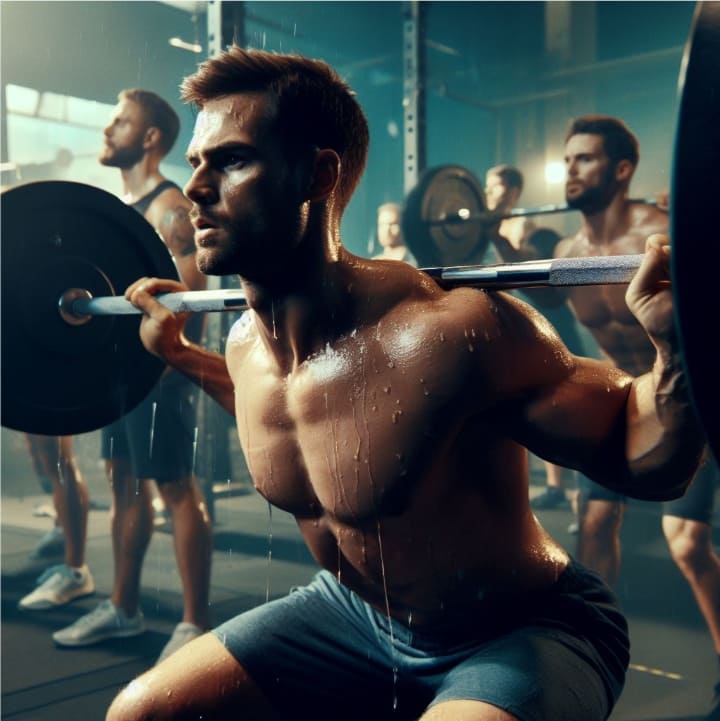
Additional Benefits of Squats
- Squats can help to improve circulation and reduce blood pressure.
- Squats can help to strengthen the pelvic floor muscles, which can help to prevent urinary incontinence.
- Squats can help to improve sleep quality.
- Squats can help to reduce the appearance of cellulite.
- Boosted energy levels
- Improved range of motion in the hips and knees
- Reduced risk of chronic diseases such as heart disease, stroke, type 2 diabetes, and some types of cancer
Incorporating squats into a regular exercise routine offers multifaceted benefits that extend beyond physical aesthetics. These advantages underline the significance of squats in improving overall health, fitness, and quality of life. Whether one’s fitness goals involve muscle gain, weight loss, injury prevention, or overall well-being, squats stand as a versatile and crucial exercise in achieving these aspirations.
How to Maximize the Benefits of Squats
To maximize the benefits of squats and ensure safety and effectiveness, it’s important to follow these guidelines:

- Master Proper Form: Before adding weight or increasing intensity, focus on mastering the correct squat form. This includes maintaining a neutral spine, engaging the core, and squatting to an appropriate depth.
- Gradually Increase Intensity: Start with bodyweight squats and gradually progress to using weights or resistance. This gradual increase in intensity will help prevent injuries and allow your muscles to adapt and grow stronger over time.
- Warm-Up and Cool-Down: Always warm up your body with dynamic stretches and light cardio before performing squats. This helps increase blood flow to the muscles and prepares them for the exercise. Similarly, cooling down with static stretches after your workout helps improve flexibility and aids in muscle recovery.
- Incorporate Variation: To continually challenge your muscles and prevent plateaus, incorporate different squat variations into your routine. This can include goblet squats, front squats, sumo squats, or single-leg squats.
- Listen to Your Body: Pay attention to how your body feels during and after squats. If you experience any pain or discomfort, modify the exercise or consult with a fitness professional.
- Rest and Recovery: Allow your muscles time to recover between squat sessions. This helps prevent overtraining and promotes muscle growth and strength development.
- Seek Professional Guidance: If you’re new to squats or unsure about proper form and technique, consider working with a certified personal trainer. They can provide guidance, correct your form, and design a program tailored to your specific goals and needs.
Note: For best results, include squats in your workout routine 2-3 times a week, with 3-4 sets of 8-12 repetitions.
Conclusion:
Squats are undoubtedly one of the most versatile and effective exercises available. With the potential to increase strength, enhance muscle mass, improve balance, and provide a myriad of other benefits, squats should be a staple in your fitness routine.
Whether you’re a bodybuilder, an athlete, or someone looking to improve their overall well-being, squats can help you achieve your fitness goals while promoting a healthier and more active lifestyle. So, start squatting and experience the incredible transformation it can bring to your life.
Incorporating squats into your fitness routine is a wise decision, offering both short-term and long-term health benefits. So, take the first step toward a healthier you and start squatting today!
Related Posts
- References:
- https://www.webmd.com/fitness-exercise/health-benefits-of-squats
- https://www.healthline.com/health/exercise-fitness/squats-benefits
- https://www.everydayhealth.com/fitness/how-to-do-a-squat-and-why-theyre-so-good-for-you/
- https://barbend.com/benefits-of-squats/
- https://www.medicalnewstoday.com/articles/benefits-of-squats
- [6] https://www.themanual.com/fitness/benefits-of-squats/
- https://www.semanticscholar.org/paper/c44b32a7cbd3946bd6f5a94075a935a60ab594be
- https://www.semanticscholar.org/paper/69b6167b8594d789c98edbe2ab31a46e8731c13d
- https://pubmed.ncbi.nlm.nih.gov/33905343/
- https://pubmed.ncbi.nlm.nih.gov/27208318/
- https://www.semanticscholar.org/paper/53977fdeccbc09069f41146114a9dc8d9f58ab7b
- https://pubmed.ncbi.nlm.nih.gov/14515936/





